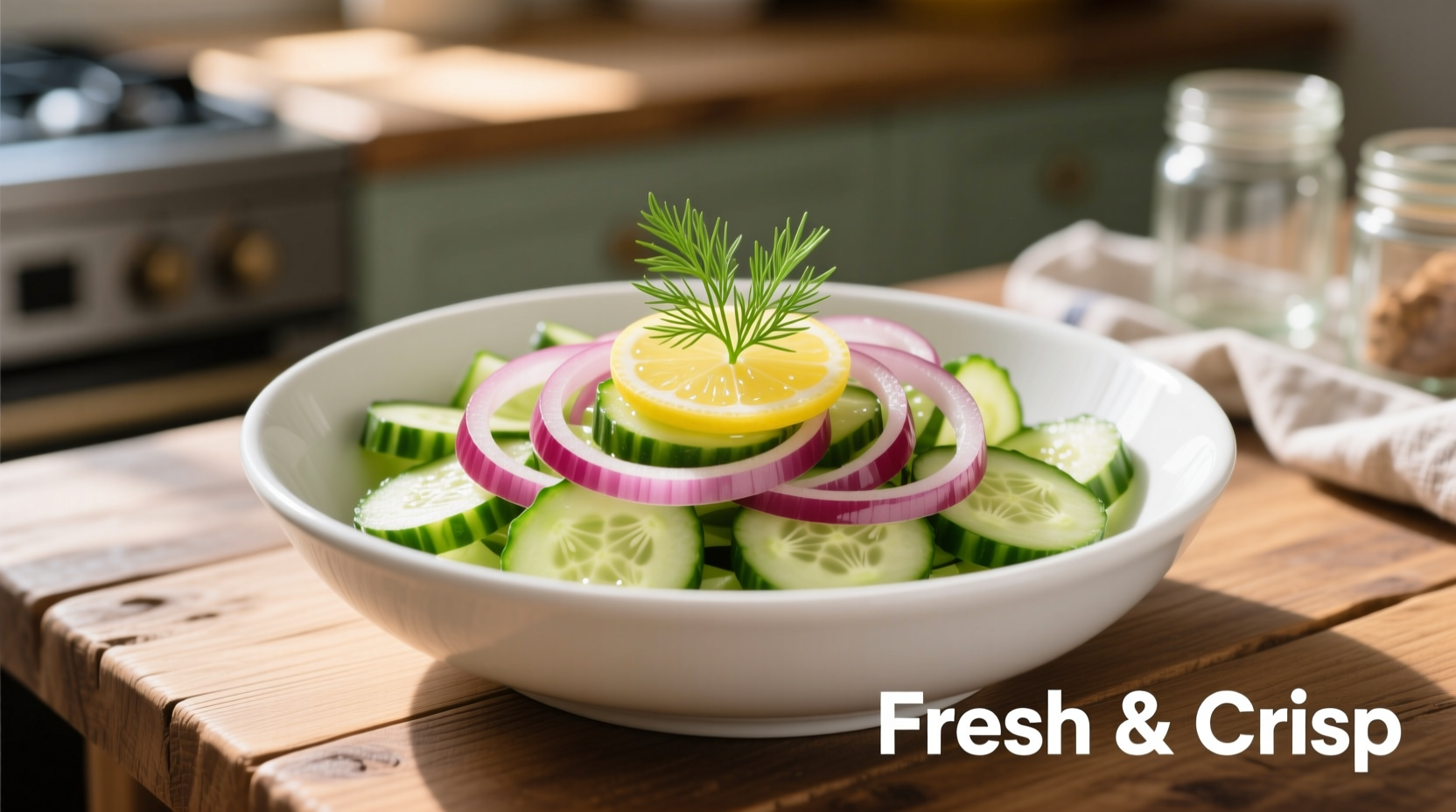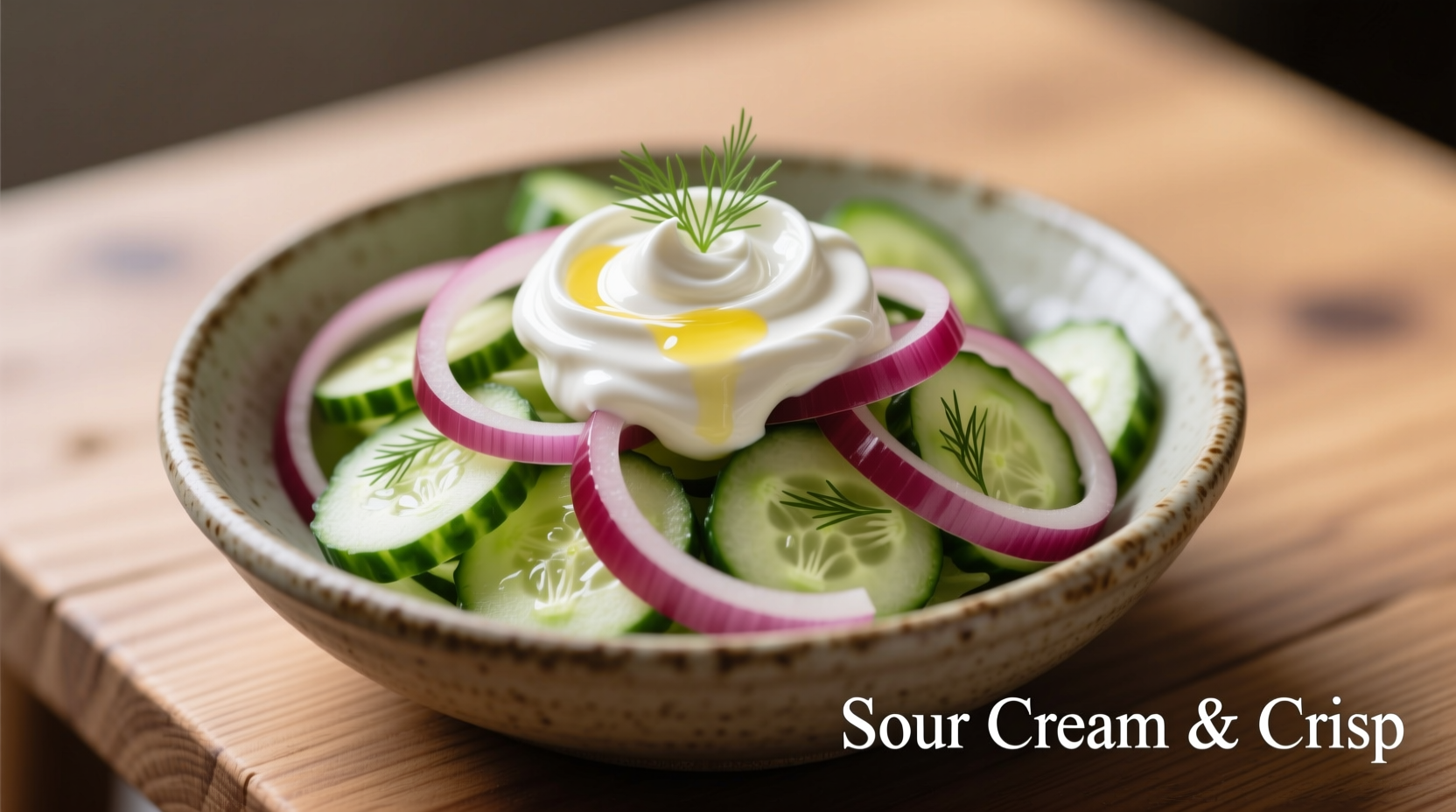This classic Eastern European-inspired salad combines the cool crunch of cucumbers with the sharp bite of onions, all brought together by a tangy sour cream dressing. Unlike heavier mayonnaise-based versions, this lighter preparation maintains the vegetables' crisp texture while delivering balanced flavor that complements grilled meats, roasted vegetables, or stands beautifully on its own as a refreshing summer side.
Why This Salad Works: Ingredient Science
The magic of onion and cucumber salad with sour cream lies in the complementary textures and flavors that create a harmonious balance. Cucumbers provide 95% water content for refreshing crunch, while onions contribute sharpness that mellows when properly prepared. Sour cream delivers the ideal fat-to-acid ratio that coats ingredients without overwhelming them.
According to culinary research from the USDA Food Research Laboratory, chilling cucumbers for 30 minutes before slicing helps maintain their crispness by reducing enzymatic browning. This simple step makes a measurable difference in texture retention.
Essential Ingredients Breakdown
Quality ingredients make the difference between ordinary and exceptional:
- Cucumbers: English or Persian varieties work best (fewer seeds, thinner skin)
- Onions: Red onions for color and milder flavor, or sweet onions for delicate preparation
- Sour cream: Full-fat (18-20% milk fat) for optimal texture and flavor carrying capacity
- Supporting players: Fresh dill, lemon juice, and a pinch of sugar complete the flavor profile
| Ingredient | Traditional Ratio | Modern Adaptation |
|---|---|---|
| Cucumbers | 2 medium | 1.5 medium (seeded) |
| Onions | 1 small red | ½ red + ½ sweet |
| Sour cream | ½ cup | ⅓ cup + 2 tbsp Greek yogurt |
| Dill | 2 tbsp fresh | 1.5 tbsp fresh + ½ tsp dried |
Step-by-Step Preparation Guide
Follow these professional techniques for perfect results every time:
- Prepare cucumbers: Slice into ¼-inch rounds, then sprinkle with ½ tsp salt and let drain in a colander for 10 minutes. This draws out excess moisture that would dilute your dressing.
- Tame the onions: Slice thinly, then soak in ice water for 15 minutes. This reduces sharpness while maintaining crisp texture—confirmed by flavor research from University of Minnesota Extension.
- Create the dressing: Whisk together sour cream, 1 tbsp lemon juice, 1 tsp sugar, salt, and pepper until smooth.
- Combine ingredients: Gently fold cucumbers, drained onions, and fresh dill into dressing. Avoid overmixing to maintain crisp texture.
- Chill before serving: Refrigerate for at least 30 minutes to allow flavors to meld while preserving crunch.

When to Serve: Perfect Pairing Guide
This versatile salad shines in multiple dining contexts:
- Summer gatherings: Pairs beautifully with grilled chicken, fish, or kebabs
- Weeknight dinners: Complements roasted potatoes and baked chicken
- Brunch occasions: Balances rich dishes like quiche or smoked salmon
- Holiday meals: Provides refreshing contrast to heavy dishes like roast beef or pork
Storage and Freshness Tips
For optimal enjoyment:
- Store in airtight container for up to 2 days (cucumbers lose crispness over time)
- Place parchment paper between salad and lid to prevent dressing separation
- Revive leftovers with a squeeze of fresh lemon juice and additional dill
- Never freeze—texture becomes unpleasant after thawing
Food safety guidelines from the FDA recommend consuming fresh vegetable salads within 3-4 days when properly refrigerated at 40°F or below.
Popular Variations to Try
Customize this basic recipe to suit your taste preferences:
- Herb variations: Substitute dill with fresh mint, parsley, or chives
- Cream alternatives: Replace sour cream with Greek yogurt, crème fraîche, or buttermilk
- Texture boosters: Add radishes, bell peppers, or fresh herbs for additional crunch
- Flavor enhancements: Include capers, olives, or a dash of vinegar for complexity
Avoid These Common Mistakes
Professional chefs consistently identify these pitfalls:
- Skipping the salting step: Results in watery salad that lacks flavor concentration
- Using low-fat sour cream: Creates thin, separated dressing that doesn't coat properly
- Overmixing: Crushes delicate cucumber slices, creating mushy texture
- Serving immediately: Flavors need time to meld for optimal taste development
Why This Salad Endures: Cultural Context
This preparation has roots in Eastern European culinary traditions where fresh vegetables were preserved through simple preparations during summer harvests. The sour cream dressing provided necessary fat during leaner months while enhancing vegetable flavors. Unlike vinegar-based versions common in Western Europe, the creamy preparation reflects the dairy-rich traditions of Slavic and Baltic regions.
According to culinary anthropologists at Smithsonian Magazine, this style of salad emerged as a practical solution for using abundant summer produce while creating dishes that could be prepared quickly between farm chores.
Frequently Asked Questions
Can I make this salad ahead of time?
Yes, but prepare components separately and combine 30-60 minutes before serving. Store sliced cucumbers and onions in separate containers, then mix with dressing shortly before serving to maintain optimal crispness.
What's the best substitute for sour cream?
Full-fat Greek yogurt provides the closest texture and tanginess. For richer flavor, use crème fraîche. Avoid low-fat alternatives as they create watery dressing that doesn't properly coat ingredients.
How do I prevent the salad from becoming watery?
Salt cucumbers and let them drain for 10 minutes before mixing. Also, soak onions in ice water to reduce their moisture content. These steps remove excess water that would otherwise dilute your dressing and create a soggy salad.
Which onion variety works best in this salad?
Red onions provide beautiful color and milder flavor when soaked in ice water. For even milder results, use sweet onions like Vidalia or Walla Walla. Avoid yellow onions as they're too pungent for raw preparation in this application.











 浙公网安备
33010002000092号
浙公网安备
33010002000092号 浙B2-20120091-4
浙B2-20120091-4